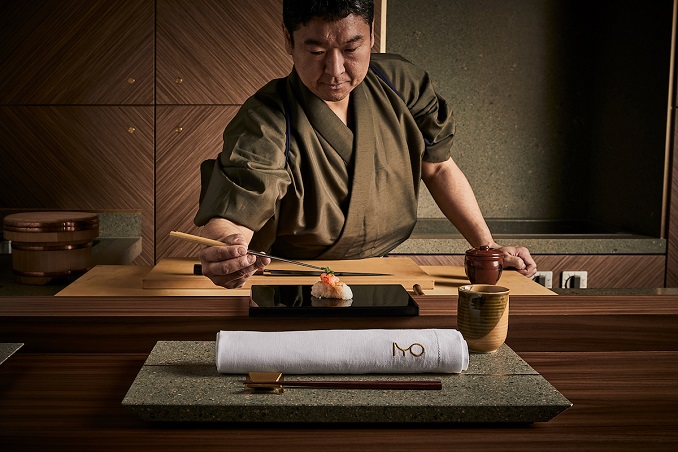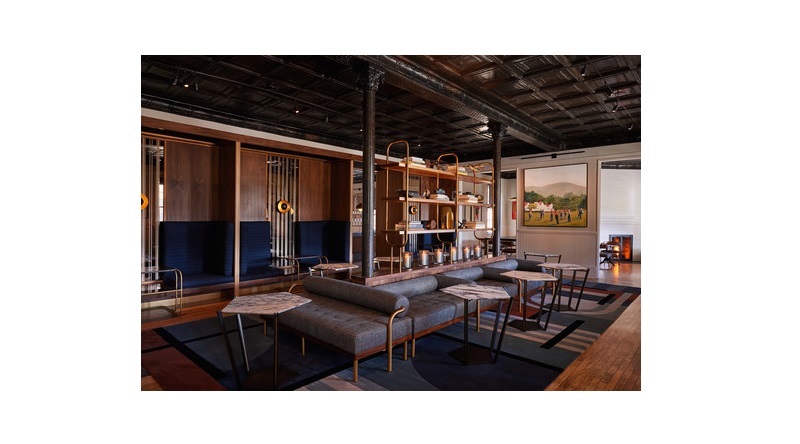There is a contemporary idea of Japan in the project that the Italian architect Maurizio Lai has developed for IYO Aalto, the second restaurant of the group after IYO Taste Experience, the only Japanese restaurant in Italy awarded a Michelin star. Subtle references to tradition give way to a contemporary and pure design language, conceiving a place where essential materials and light merge into a different narrative.
Maurizio Lai defines a restaurant where the founding values of IYO are transferred to the space. IYO Aalto offers a dual experience, in environments designed right down to the smallest detail: Tokyo’s Edomae zushi culture, in a traditional “Sushi Banco”, and a boundless and contemporary cuisine in the elegant “Gourmet Restaurant”.
The space of 320 square meters embraces the open kitchen, the wine cellar, the exclusive “Sushi Banco” and the “Gourmet Restaurant”. Natural materials — walnut, porphyry, brass, leather — are combined with sophisticated and more technological elements.
Maurizio Lai evokes the suggestions of a contemporary Japanese culture through a decisive sensibility, far from prevailing stereotypes and clichés. IYO Aalto appears like a preciously balanced stratification of details, characterized by the discreet and constant presence of design elements that enrich and define the personality of each environment and surface. Furniture is made exclusively on design in collaboration with Poliform Contract: a vibrant example of the peculiar relationship between architects and Italian brands; a collaboration able to give shape to ideas, turning them into unique products thanks to bespoke process and artisanal know-how.
The interior project
The entrance introduces a timeless and dreamlike dimension: a compass with float glass plates and smoked mirrors expands the space, in a game of transparency and infinite reflections. On the inside, guests are welcomed by a light installation and a desk, made of flamed gray-green porphyry and brass, which introduces a dialogue between form and material that will continue throughout the restaurant.
IYO Aalto is defined by the discreet and constant presence of signs that distinguish all the surfaces: small brass inlays drowned in the wooden slats of the floors; swallow tails – also in brass – that recall the culture of high carpentry, up to the furniture screws.
Canaletto walnut and porphyry represent the dominant materials. The walls, never continuous, define and delimit spaces without ever completely isolating them: like the imposing central partition in slabs of split porphyry, flanked by brushed surfaces and void parts. Furniture and fittings, entirely custom-made, are produced in collaboration with Poliform Contract.
The Sushi Banco
An intimate room proposes for 8 guests the Japanese edomae zushi: a set of rituals that has its roots in the Bunsei era (1818-1830), where the nigiri are prepared in front of the guest.
The entrance wall is made with Brise Soleil in Canaletto walnut and allows a glimpse of both the internal environment and the lofty window.
The counter is in Canaletto walnut, with worktop and plates in smooth gray-green porphyry, characterized by thin brass inlays. The leather seats, with a black elm structure and a leather-coloured custom-made cladding (used also for the upholstered furniture in the main dining room), are produced by Poliform Contract. The brand was in charge of the realization of the whole custom-made furnishing, joinery, glassware and stone works.
The Gourmet Restaurant
The extraordinary heritage of Japanese cuisine is filtered by contemporary knowledge to offer an authentic and ambitious experience, in a room designed to accommodate a maximum of 38 seats.
The Canaletto walnut covers all the surfaces of the space and the ceiling is embellished with lacunar sheets of float glass: a touch of lightness to rediscover the classic codes of coffered ceilings, reinterpreted by Maurizio Lai according to a contemporary aesthetic.
Three wooden wall cabinets mark the space; custom-designed, they represent some of the recurring details of the project: brass screws, wood, leather, glass. As if suspended, they are surrounded by a perimeter escape that becomes a design element, an interpretation of Japanese poetry that considers emptiness as balance. Materials and surfaces are combined without ever touching, in a game of poetic absences.
The wall-mounted wine cellar is one of the largest ever made: 3.5 m x 10 m, with six different temperature zones, to accommodate up to 1600 bottles. Consisting of a polished stainless core, it has reflective smoked glass doors (also used for ceiling cladding) and interior lighting.
In the restrooms, luminous vertical and horizontal lines play with dark vertical surfaces, mirrored at full height, alternating with sheets of back-lacquered glass and round mirrors with LED backlights. Polished floors and ceilings made with recycled glass grit slabs get reflected, thus multiplying the space, causing an unexpected effect and adding a level of experience to the project.








